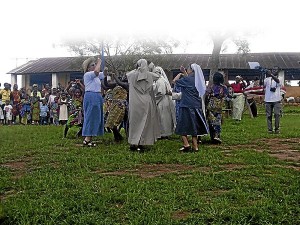 I was very excited when, in our meeting of the Administrative Council of Communio Internationalis Benedictinarum (CIB), the international association of Benedictine abbesses and prioresses, it was decided that our conference this year would be in West Africa—Burkina Faso, Togo, Ghana and Benin!
I was very excited when, in our meeting of the Administrative Council of Communio Internationalis Benedictinarum (CIB), the international association of Benedictine abbesses and prioresses, it was decided that our conference this year would be in West Africa—Burkina Faso, Togo, Ghana and Benin!
I left the Philippines for Hong Kong on Aug. 30 at 3 p.m., one hour later than our schedule. The first country in my itinerary was supposed to be Burkina Faso, where members of the CIB Administrative Council, including myself, were supposed to meet.
Well, I never got there. In the waiting lounge, I was approached by the staff of Ethiopian Airlines, asking for my visa to Burkina Faso. I told him that the organizer assured me that I needed only two pictures and a visa fee, and I would be given one at the Ouadagugo Airport. No, he said, I must have either a visa or a letter from their ministry.
There was a lot of telexing and telephoning, but no dice. Verdict: No go. So my agent got me a new ticket: Hong Kong-Addis Ababa-Lome.
Meanwhile, I spent two nights and three days in Hong Kong talking with Filipino migrant workers. The Pinays working in the Lounge, Jeannette and Leonor, shared with me their life stories, their blankets and food. I got to talk with groups of overseas Filipino workers who came and went, and I felt as if I was a resident of the airport, greeting transients. I got to hear many stories, and I began to think that there really was a reason why I was stranded in Hong Kong.
The next day, I was finally able to board Ethiopian Airlines, and after 10 hours, landed in Addis-Ababa. At Lome, Sister Marie, who was our local organizer, met us and brought us to the Salesian Sisters, where we spent a night.
The next day, we took a five-hour bus ride to this place in the mountain called Dzogbegan, the venue of our meeting, the Assumption Monastery of the Benedictine Sisters. There was a typical African opening ritual and opening prayer. There was even an item in the first day program where I was formally congratulated for the 100 Women Citation.
Hot water in French
By the way, everything is French here—prayers, conversation, signs on the road, etc. I was pleasantly surprised that my one-month French course in Paris a long time ago enabled me to understand almost everything, and to engage in simple conversations like, “Where can I get hot water? When will the store open?” Maybe necessity also forces you to understand.
I like the nuns’ liturgy. Their divine office beautifully combines African rhythm with Gregorian chant. There are 33 nuns, and the order was founded in 1966. They have many enterprises: yogurt-making, bread baking, fruit and vegetable preservation, handicraft, wine making, and vestment making.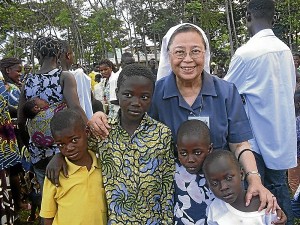
The chief of the village gave us a formal welcome. He is a very good Catholic, having only one wife, and was formerly an elementary school teacher. He speaks very good English. In his toga-like cloth, gold headdress, and gold sandals, he looked very regal indeed. The whole village gathered and danced for us, and invited us to dance with them. We enjoyed following their steps, but it was impossible to follow their hip movements. They really have a complicated way of moving their butts!
We went to Ghana, a neighboring country, to see their waterfall. It was supposed to be just one hour away from our village, but the border was like a police barricade. We walked four kilometers to the falls. It was gorgeous, but it was a strenuous trek because we had to help bring our picnic pots, and the rain made the road quite slippery.
On the last day of our meeting, we celebrated the 10th anniversary of CIB. The sisters of the community danced, sang, and made music for us. I got to learn how to beat their drums; I got the rhythm right away, but I never realized it took more than a bit of energy. One’s whole body is engaged, and the arms can become painful afterwards!
I learned very soon the elasticity of African time. They have a saying which goes, “You have the clock, we have the time.” Our 7:15 breakfast can be as late as 7:45. The supposed one-hour walk to the waterfall in Ghana took us some three hours.
On Sept. 10, we were told we would have breakfast at 5 a.m. before our 500-km drive to Kara in the north of Togo. We, of course, left at 6:30, and it took us 15 hours to drive to Kara on village roads like moon craters.
Chapel shaped like an egg
We passed the Emmanuel Monastery of the St. Ottilien monks. They have an oval chapel shaped like an egg, and its central part, where the altar stands, is supposed to be the the yolk of the egg. They have 200 elementary and high school students who live nearby in the village. Beside them is a mosque, because the area is mostly occupied by Muslims.
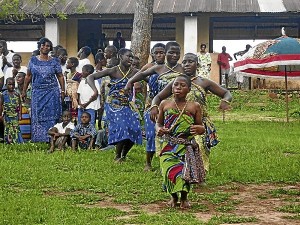 After another long drive, we finally reached our final goal in Sador—Monastere de l’Incarnation, a convent founded by the Monastery at Dzogbegan. We almost could not believe we had arrived. “This is a lesson in infinity!” said Sister Marie. And how, I said. I think I understand a little more what “dura et aspera” means, which was taught to us as novices, describing the hard and rough road in the spiritual journey.
After another long drive, we finally reached our final goal in Sador—Monastere de l’Incarnation, a convent founded by the Monastery at Dzogbegan. We almost could not believe we had arrived. “This is a lesson in infinity!” said Sister Marie. And how, I said. I think I understand a little more what “dura et aspera” means, which was taught to us as novices, describing the hard and rough road in the spiritual journey.
After a moment of prayer at their chapel, we had a quick supper and proceeded to our rooms. We had to share rooms, and we had to wait for our luggage, which had to be brought down from the roof of the bus. We finally went to bed at 11 pm!
Although there are only seven nuns in the community, they are taking care of a very large complex. They also have yogurt making as one of their livelihood activities. They provide a contemplative presence in this largely Muslim community.
I took a walk in their garden, and got a souvenir on my body for it. After breakfast, when I was about to board the bus, I felt an itch on my left leg. When I looked at it, I was shocked. My whole knee and half of my leg was full of bites, not unlike that you get when a caterpillar from an acacia tree alights on you. It looked terrible, angry red with rows of round welts. Sister Anne gave me antiallergenic crème, and the African sisters bought me antiallergy pills.
It took us almost an hour at the border going to Benin to have all 28 passports stamped. And so we arrived again after 15 hours at a beautiful Spiritual Study and Prayer Center, Notre Dame de l’Esperance, on top of a mountain. But we were too exhausted to appreciate it, especially as our luggage had to be carried from the bottom of the hill.
The center is made up of round modules, with a big statue of a saint on top of it. The one in charge is Fr. Louie Hondololo who, when he was in Italy studying in the Augustinianum, met a Dominican nun, who told him that she saw in a vision a knoll where a spiritual center should be built.
When he showed her the place where he was planning to put one up, she said that was exactly the place she saw in her dream. Her statue stands in one of the modules.
The whole compound can only accommodate 16 guests. The place was cool, and at night, we had our doors open and slept with the evening breeze blowing gently into our rooms.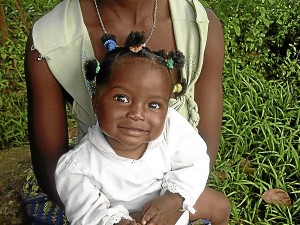
Matriarchal society
After lunch the next day, Fr. Louie gave us a very interesting lecture on “Woman from the African Perspective.” He said that African society is largely matriarchal and life-centered, just as oriental society is way-centered, and western society, truth-centered. He said that African wisdom says man comes from woman, but woman comes from herself, and therefore shares in the great mystery of the Divine.
Unlike in a patriarchal society, where the predominance of men necessarily involves an antagonism with and even oppression of women, in the matriarchal society, there is no such antagonism. She is the source of life, of family, and of the community.
In marriage, the woman does not only marry the man, but the whole family. All the brothers of the husband can call her “my wife,” and she calls all of them “my husband,” a fact which became a difficulty for a seminarian who was about to be expelled when the rector read from a letter of his family: “Your wife has just given birth.” It turned out that the woman was his sister-in-law!
After the talk, we had Holy Mass, followed by lunch and off we went on to our next destination: the Museum of the Royal Palaces of Abomey. This became a World Heritage site in 1982. There were 12 kings of the Dahomey people from the 16th to the 19th centuries, and the last King Ghebanzin, who fought against the French colonizers, was deposed and sent into exile in Algeria and Martinique.
It all began with the slave trade, when the European countries started to capture Africans with the connivance of their native rulers and sell them to America and Europe, under terrible conditions. Even the Dahomey kings participated in this horrible trade. It is estimated that about 6,000,000 slaves were bought and sold until the abolition of slavery in the 19th century.
This abolition was not completely altruistic, because after the slave trade provided the capital and resources for the industrial revolution, the Europeans no longer needed slaves because of the machines, but rather workers and consumers.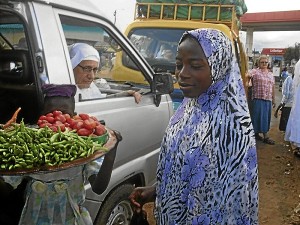
We went through the different courtyards of the museum, which occupies 45 hectares and includes former palaces of the kings, each one adding his own courtyard. We were shown the thrones, symbols of power, weapons, articles used by the royal family.
A king would have about 4,000 wives, and we were told that when one of the kings died, 200 of his wives offered to die with him, but only 40 were accepted, and they showed us their tomb, which has a subterranean passage to the tomb of the king in the other courtyard, showing that “love went beyond the grave!”
‘Prime minister’
The tomb was plastered with the combined blood of people and animals. We were told that the king gave the Portuguese 200 slaves and 25 beautiful young women. There was a statue of a man called “prime minister,” but his job was actually to cut off the heads of condemned criminals. He must only use one stroke; otherwise he would lose his own head.
The last pavilion shown to us was about French colonization and the deposition and exile of King Gbehanzin. The whole Unesco project highlights the true meaning of the tragedy lived by King Gbehabzin, who was called “a sovereign of great dignity and exceptional independent spirit.”
After the visit to the museum, we proceeded to the Convent of St. Joseph in Toffo, which was founded in 1966 by French nuns. They have a beautiful 35-ha land with a very artistically decorated chapel, which has as its main motif the tree, the symbol of life and monasticism. The rooms were very airy, and we all slept very well that night.
The next day, the bishop came to visit us, and gave us the situation of the diocese and his vision as bishop, which is to encourage hope, especially among the young people. He and some companions said the Mass and ate with us. It happened to be Sept. 14, our Foundation day in the Manila priory, so I bought ice cream for the whole group, which was very much appreciated.
On our way home to Togo, we passed by Ouidah, where the slave market used to be, and where there is a pilgrimage site. We started at the Chacha (hurry, hurry) place, where the slaves taken from all over Abomey were brought to a prison. Here, they were fattened up to look strong when they are exhibited around the big tree, where there is now a statue of a slave.
Then we went to a place where they showed what happened to those who were rebellious. They were not only shackled, but their mouths gagged with a slab of wood so they could not encourage others to rebel.
Then came the big monument, which pictured the different stages of the journey, from the capture, to their being put on a ship, packed like sardines. The women had to lie on their backs, and the men had to make them pregnant so that there would be additions to the slaves.
There is also the tree of forgetfulness, supposedly a magical tree which the slaves were made to go around three times to supposedly forget who they were and what they were. There is also another tree, which the men had to go around nine times and the women seven times. This was supposed to reassure them that their spirits would return here someday, even if they would never physically return.
This is again dramatized at the port, where there is the Gate of No Return. Then slaves knew that when they got on the ship, they would no longer come back. In this place, many committed suicide, preferring to die in their homeland.
Then we were brought to the Door of Return, where a statue of Mother Africa welcomes a woman and a man dressed in Western clothes, signifying the wish that those who have been brought to other lands, especially America, and have found good fortune would someday return to work for the betterment of their homeland. Wishful thinking. But they can dream, can’t they?









































